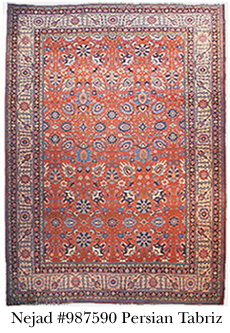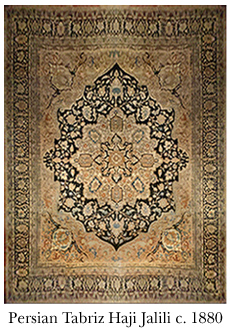About Persian Tabriz Antique Oriental Rugs
Brief Overview
Tabriz, the capital city of the East Azarbaijan Province of Iran, is one of the most important and historically significant rug-producing centers of the world. Throughout the centuries, many different types of rugs were made there, including pile and flat-woven, incorporating various designs and compositions from the simple to the complex. Either drawn from the works of the great Oriental poets, or inspired by the hand-painted covers of ancient books, such imagery included the depiction of palaces, mosques, farming or battle scenes - even animals (eg. falcon or lion).

Nejad's #987980 Antique (circa 1960) 100% wool pile
Persian Tabriz Bird of Paradise 6' 5" x 10' Directional carpet on hardwood floor.

Nejad's impressive #987509 Persian Tabriz 4' 9" x 6' 10"
very decorative Directional semi-antique - c. 1940s - carpet on hardwood floor.
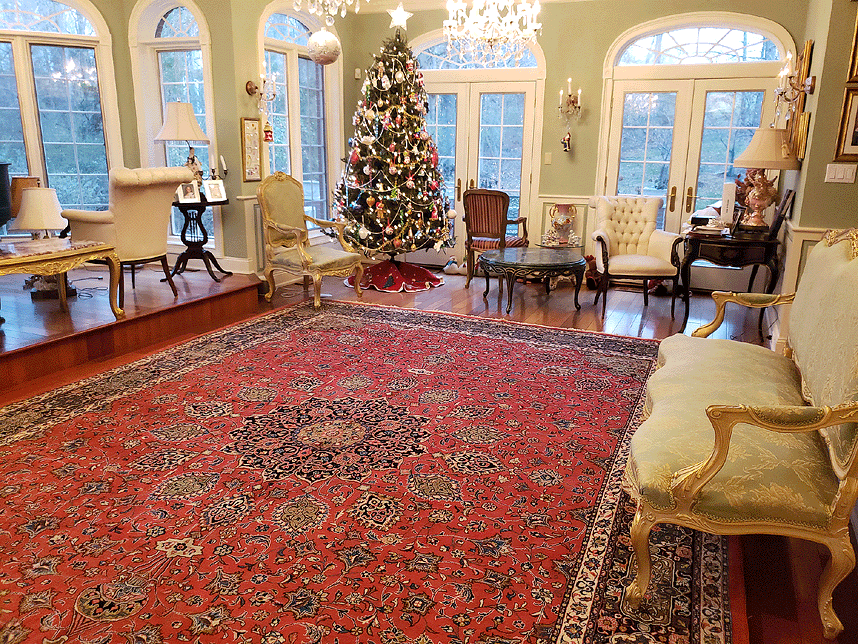
Nejad's Persian Tabriz 11' × 16' Ardabil Carpet with Cherry Red Field and Indigo Border displayed in Client Home in Newtown, PA
Design similar to one of the most important antique rugs displayed at the
Victoria & Albert Museum, London
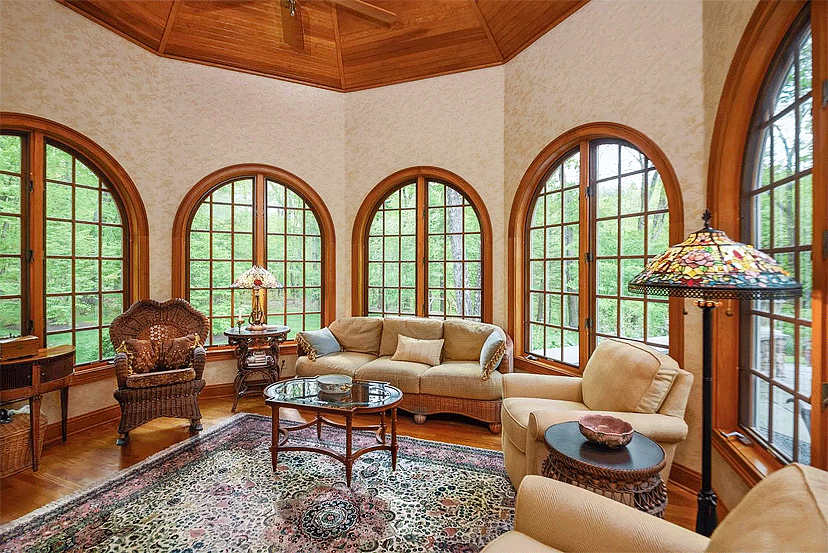
Tabriz Rug in Room Setting - Very Fine Silk Foundation Silk & Wool Pile Tabriz Carpet in Nejad Client Bucks County Estate Home
The Tabriz Rug Style
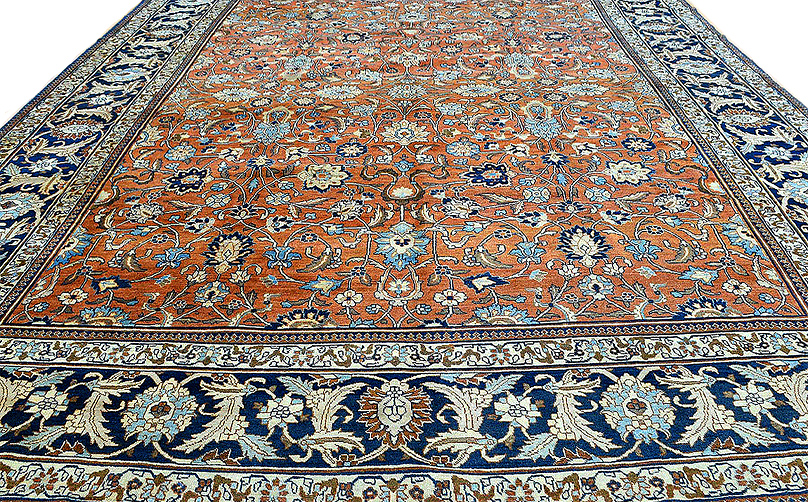
An exquisite, investment-quality antique Fine Persian Tabriz rug
9.9' × 12.10' c. 1900 is currently being offered by Nejad Rugs
of Doylestown, PA.
[ Nejad Rug #987724 - Rust / Navy ]
Today, however, the typical theme for Tabriz carpets - or the style of rug most-readily identifiable as Tabriz - are the finely-orchestrated ornamental patterns, including the colorful and intricately-interwoven thistle-like figures, flowers, scrolling vines, stems and leaves typically set on a predominant field-color of ivory, burgundy-red or navy-blue and featuring either a uniform all-over design or [usu.] an ornate center-medallion accompanied by 4 corner spandrels - the overall effect of such an arrangement often imbuing the woven artwork with a majestic or regal character.
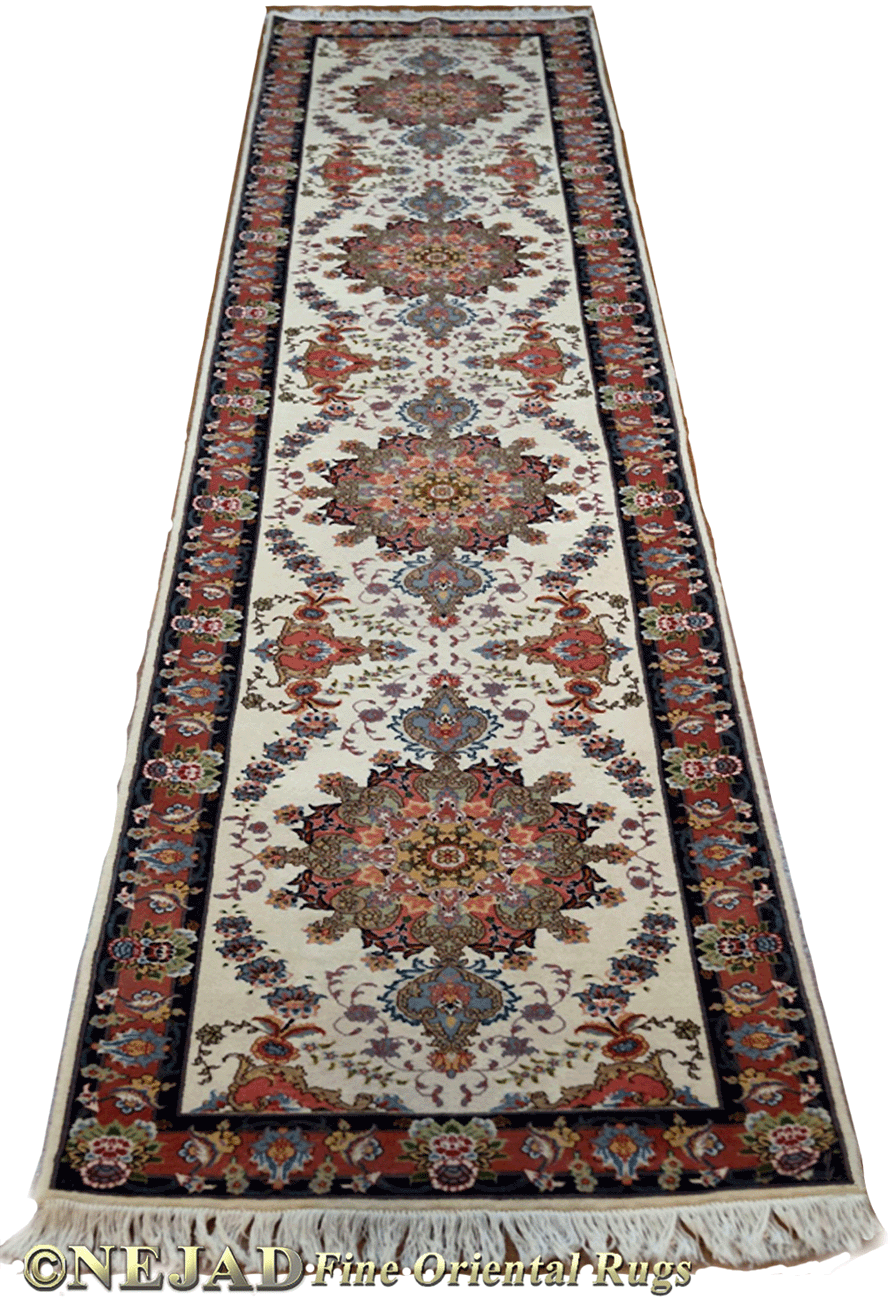
Nejad Rugs Catalog #988057 Genuine Persian Tabriz Elegant
Silk & Wool Hallway Runner 2 ft. 9 in. x 12 ft. 7 in. Ivory / Rust
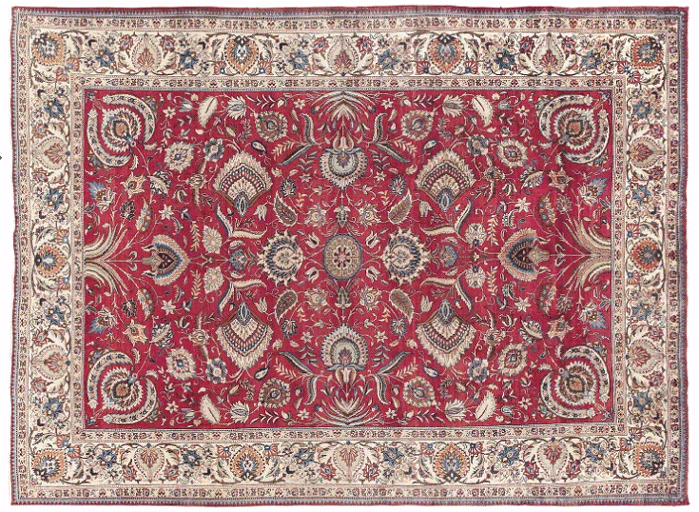
This Mid-20th Century 12' 11" × 9' 7" Tabriz Rug Northwest Persia
sold at Christie's for nearly twice the estimated value.
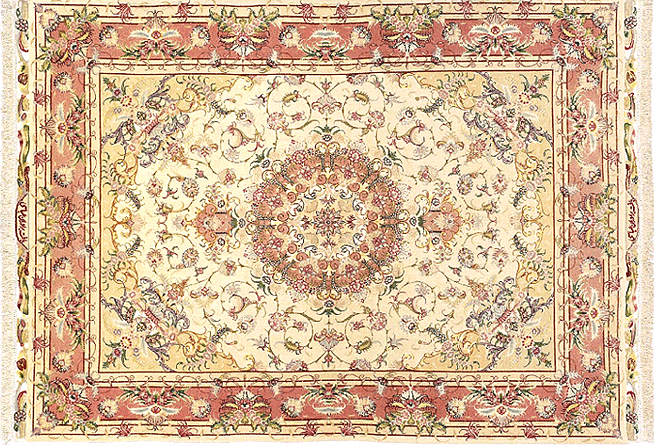
A very fine mid-20th Century 6' 10" × 4' 10" silk
and wool Tabriz medallion rug sold at Christie's London.
The City of Tabriz
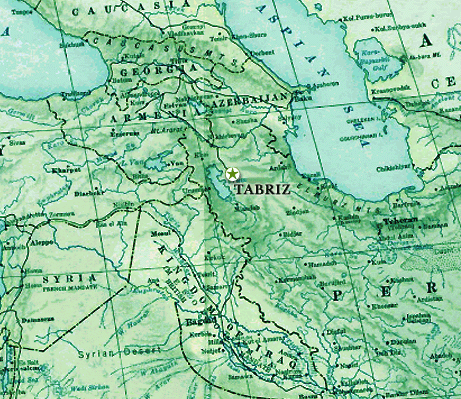
On the Silk Road, Tabriz is one of the
most historically significant rug-producing centers of old Persia and modern-day Iran
Roughly equidistant to the Caspian Sea in the east, the rug-making center of Bidjar to the south, and Mt Ararat to the north, and situated in the northwest corner of Iran on the famous Silk Road, Tabriz has been a place of cultural exchange and commerce since antiquity. Marco Polo, who traveled the Silk Road and passed through Tabriz in approx. 1275 CE, described it as "a great city surrounded by beautiful and pleasant gardens. It is excellently situated so the goods brought to here come from many regions. Latin merchants go there to buy the goods that come from foreign lands." That Tabriz has retained its stature as one of the most important commercial carpet centers is evidenced by the spectacular Tabriz Bazaar Complex (pictured above), the world's largest covered bazaar, which features the historic Carpet Bazaar - Mozzafarieh.

The Old Silk Routes (from Istanbul to Xian, China) through Persia
showing the prominent rug-producing cities
Consumer Notes
It was in 1880 and afterward, as the production of Tabriz Oriental rugs was increasing to meet western demand, that the standard size ratio of 2:1 (typical size: 6' 6" × 13') suitable to the indigenous Persian rug-buying market began to transition over to the modern European size ratio of 3:2 (commonly 8' × 11' or larger). Due to the superior quality of wool and finely-woven dense pile of these rugs, it is not uncommon to find them in very good to excellent condition today.
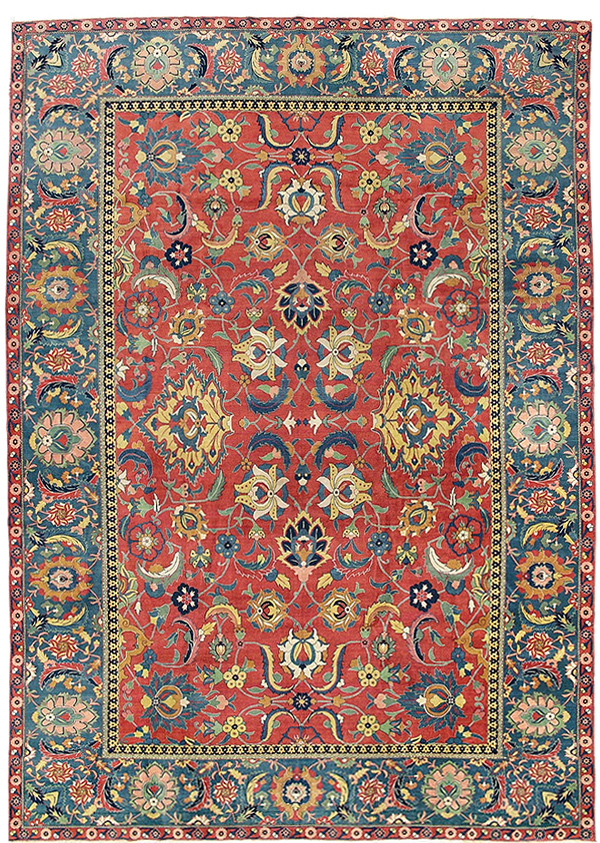
An exceptional signed Petag Tabriz carpet, northwest Persia, circa 1920.
( 18' 4" × 12' 8" )
This room-sized antique rug sold for £25,000 on April 27, 2017 at Christie�s in London.
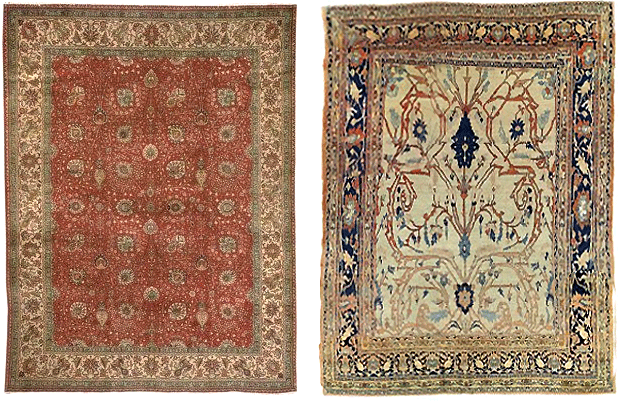
Two turn-of-the-20th-century Haji Jalili Tabriz carpets
from North-West Persia (Christie's, London)
(left) 7' 9" × 6' 3" £1,875 /
(right) 14' 7" × 11' estimated value at auction: £2,000-£3,000.
Haji Jalili Rugs - Recognized for many years as the highest grade of Tabriz rugs, these fine-quality, now rare (few actual signatures exist), Haji Jalili rugs were originally made for prestigious families and institutions. The workshops and craftsmen that produced these rugs (late 19th Century) are renowned among collectors for their expert weaving skills and use of high-quality materials which meet the highest of standards for Tabriz rugs. When compared to the typical Tabriz rug these masterpiece carpets - produced in Marand, some 40 miles northwest of Tabriz - exhibit more intricate and intriguing patterns as well as more diverse coloration and a finer weave quality.
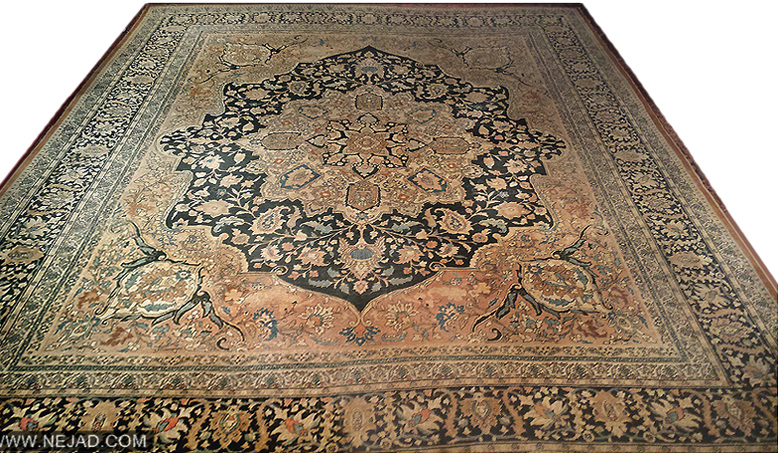
This large, rare heirloom antique (circa 1900) Haji Jalili 9' ×
12' Persian Tabriz rug is currently being offered by Nejad Rugs.
Now produced in various locations throughout the world - the Persian Tabriz style rug continues to retain its popularity as one of the best-selling rug designs. Some of the major Tabriz rug producers in Iran today who are still producing traditional, fine-quality hand-knotted rugs include Alabaf of Tabriz, Galibafi Nassadji and Miri Brothers.
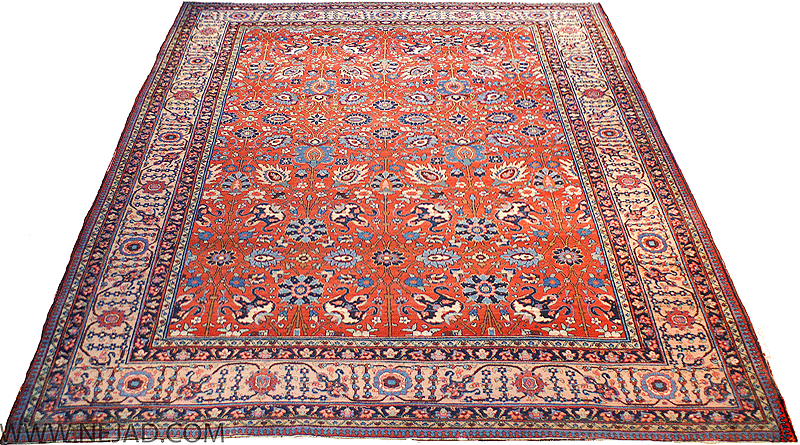
A beautifully-detailed, investment-quality antique Fine Persian Tabriz
rug 8.5' × 11.6' is currently being offered by Nejad Rugs
[
Nejad Rug #987590 - Rust / Tan - All-Over design ]

Nejad's #987509 very decorative Persian
Directional Tabriz Rug - 4' 9" x 6' 10" / semi-antique c. 1940s
Nejad Rugs is a designer, manufacturer and importer of Oriental and contemporary rugs
with several Tabriz rug designs offered through an extensive viewable-online catalog.
Currently Nejad is offering the following antique Tabriz rugs for sale:
About:
Tabriz Antique Rugs | Heriz Antique Rugs | Mashhad Antique Rugs | Sarouk Antique Rugs | Kashan Antique Rugs
Kerman Antique Rugs | Serapi Antique Rugs | Bidjar Antique Rugs | Karabagh Antique Rugs | Senneh Antique Rugs
Bakhtiari & Antique Bakhtiari Rugs | Nain and Antique Nain Persian Rugs | Ziegler Mahal Antique Persian Rugs
Esfahan & Antique Esfahan Rugs | Qum Antique Rugs | Farahan Antique Rugs | Darjazin-Hamadan Antique Rugs
Hereke Antique Rugs | Akstafa Antique Rugs | Antique Gharajeh Rugs | Chichi Antique Rugs | Mudjar Antique Rugs
Kazak Antique Rugs | Shirvan Antique Rugs | Beluch Antique Rugs | Peking Antique Rugs | Kurdish Antique Rugs
Turkeman Antique Rugs | Dagestan Antique Rugs | Flemish Antique Tapestry | Antique Ming Chinese Rugs
French Aubusson Antique Tapestry
- after Francois Boucher
